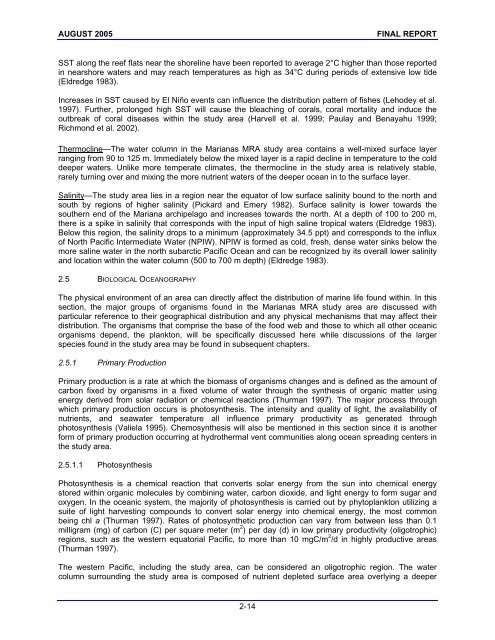Marine Resources Assessment for the Marianas Operating ... - SPREP
Marine Resources Assessment for the Marianas Operating ... - SPREP
Marine Resources Assessment for the Marianas Operating ... - SPREP
Create successful ePaper yourself
Turn your PDF publications into a flip-book with our unique Google optimized e-Paper software.
AUGUST 2005 FINAL REPORT<br />
SST along <strong>the</strong> reef flats near <strong>the</strong> shoreline have been reported to average 2°C higher than those reported<br />
in nearshore waters and may reach temperatures as high as 34°C during periods of extensive low tide<br />
(Eldredge 1983).<br />
Increases in SST caused by El Niño events can influence <strong>the</strong> distribution pattern of fishes (Lehodey et al.<br />
1997). Fur<strong>the</strong>r, prolonged high SST will cause <strong>the</strong> bleaching of corals, coral mortality and induce <strong>the</strong><br />
outbreak of coral diseases within <strong>the</strong> study area (Harvell et al. 1999; Paulay and Benayahu 1999;<br />
Richmond et al. 2002).<br />
Thermocline—The water column in <strong>the</strong> <strong>Marianas</strong> MRA study area contains a well-mixed surface layer<br />
ranging from 90 to 125 m. Immediately below <strong>the</strong> mixed layer is a rapid decline in temperature to <strong>the</strong> cold<br />
deeper waters. Unlike more temperate climates, <strong>the</strong> <strong>the</strong>rmocline in <strong>the</strong> study area is relatively stable,<br />
rarely turning over and mixing <strong>the</strong> more nutrient waters of <strong>the</strong> deeper ocean in to <strong>the</strong> surface layer.<br />
Salinity—The study area lies in a region near <strong>the</strong> equator of low surface salinity bound to <strong>the</strong> north and<br />
south by regions of higher salinity (Pickard and Emery 1982). Surface salinity is lower towards <strong>the</strong><br />
sou<strong>the</strong>rn end of <strong>the</strong> Mariana archipelago and increases towards <strong>the</strong> north. At a depth of 100 to 200 m,<br />
<strong>the</strong>re is a spike in salinity that corresponds with <strong>the</strong> input of high saline tropical waters (Eldredge 1983).<br />
Below this region, <strong>the</strong> salinity drops to a minimum (approximately 34.5 ppt) and corresponds to <strong>the</strong> influx<br />
of North Pacific Intermediate Water (NPIW). NPIW is <strong>for</strong>med as cold, fresh, dense water sinks below <strong>the</strong><br />
more saline water in <strong>the</strong> north subarctic Pacific Ocean and can be recognized by its overall lower salinity<br />
and location within <strong>the</strong> water column (500 to 700 m depth) (Eldredge 1983).<br />
2.5 BIOLOGICAL OCEANOGRAPHY<br />
The physical environment of an area can directly affect <strong>the</strong> distribution of marine life found within. In this<br />
section, <strong>the</strong> major groups of organisms found in <strong>the</strong> <strong>Marianas</strong> MRA study area are discussed with<br />
particular reference to <strong>the</strong>ir geographical distribution and any physical mechanisms that may affect <strong>the</strong>ir<br />
distribution. The organisms that comprise <strong>the</strong> base of <strong>the</strong> food web and those to which all o<strong>the</strong>r oceanic<br />
organisms depend, <strong>the</strong> plankton, will be specifically discussed here while discussions of <strong>the</strong> larger<br />
species found in <strong>the</strong> study area may be found in subsequent chapters.<br />
2.5.1 Primary Production<br />
Primary production is a rate at which <strong>the</strong> biomass of organisms changes and is defined as <strong>the</strong> amount of<br />
carbon fixed by organisms in a fixed volume of water through <strong>the</strong> syn<strong>the</strong>sis of organic matter using<br />
energy derived from solar radiation or chemical reactions (Thurman 1997). The major process through<br />
which primary production occurs is photosyn<strong>the</strong>sis. The intensity and quality of light, <strong>the</strong> availability of<br />
nutrients, and seawater temperature all influence primary productivity as generated through<br />
photosyn<strong>the</strong>sis (Valiela 1995). Chemosyn<strong>the</strong>sis will also be mentioned in this section since it is ano<strong>the</strong>r<br />
<strong>for</strong>m of primary production occurring at hydro<strong>the</strong>rmal vent communities along ocean spreading centers in<br />
<strong>the</strong> study area.<br />
2.5.1.1 Photosyn<strong>the</strong>sis<br />
Photosyn<strong>the</strong>sis is a chemical reaction that converts solar energy from <strong>the</strong> sun into chemical energy<br />
stored within organic molecules by combining water, carbon dioxide, and light energy to <strong>for</strong>m sugar and<br />
oxygen. In <strong>the</strong> oceanic system, <strong>the</strong> majority of photosyn<strong>the</strong>sis is carried out by phytoplankton utilizing a<br />
suite of light harvesting compounds to convert solar energy into chemical energy, <strong>the</strong> most common<br />
being chl a (Thurman 1997). Rates of photosyn<strong>the</strong>tic production can vary from between less than 0.1<br />
milligram (mg) of carbon (C) per square meter (m 2 ) per day (d) in low primary productivity (oligotrophic)<br />
regions, such as <strong>the</strong> western equatorial Pacific, to more than 10 mgC/m 2 /d in highly productive areas<br />
(Thurman 1997).<br />
The western Pacific, including <strong>the</strong> study area, can be considered an oligotrophic region. The water<br />
column surrounding <strong>the</strong> study area is composed of nutrient depleted surface area overlying a deeper<br />
2-14
















